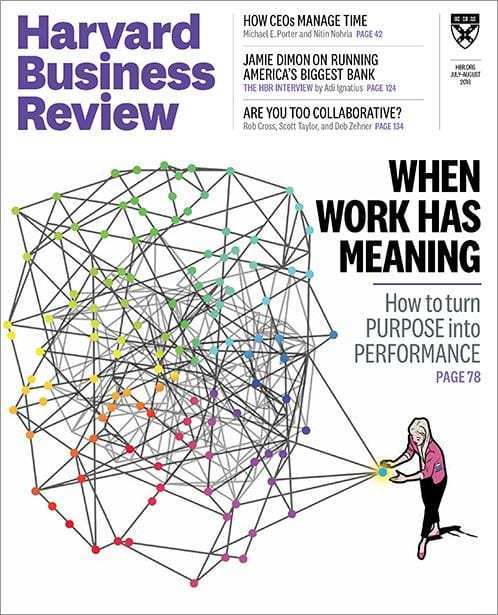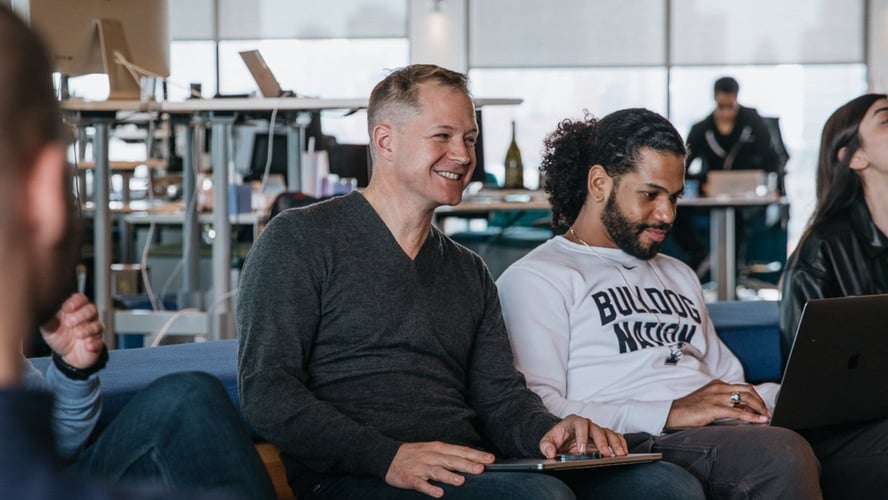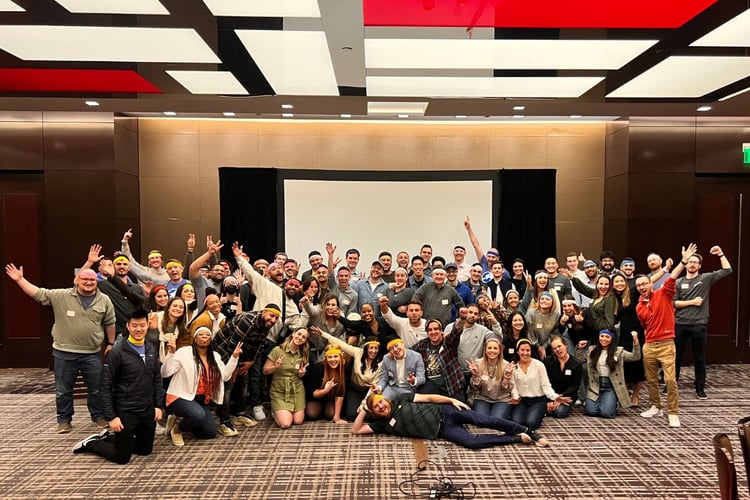Helping purpose-driven people find purpose-driven startups is at the heart of all we do. (Hence: “regarding purpose,” or, re:purpose).
So when we saw that the cover story for the July/August 2018 issue of the Harvard Business Review was about turning purpose into performance, we were delighted.

The article defines purpose at work like this:
“A higher purpose is not about economic exchanges. It reflects something more aspirational. It explains how the people involved with the organization are making a difference, gives them a sense of meaning, and draws their support.”
It goes on to identify eight steps that can help leaders find and leverage purpose within their own organizations (summarized below)—but not before telling the tale of DTE Energy, and the president who, before it transformed his organization top to bottom, was skeptical of the role that purpose could play at DTE.
The role of purpose at DTE
When the 2008 recession hit, Gerry Anderson, president of DTE, knew that a committed workforce would be vital to surviving the financial crisis. But he didn’t know how to get one. Even before the recession hit, a recent survey showed that DTE employees weren’t very engaged. According to the article, “[Anderson] had tried providing training, altering incentives, and increasing managerial oversight, with disappointing results. It turned out that his approach was to blame—not his people.”
Willing to think outside of the box, Anderson reached out to Joe Robles, a retired army major general who was, at the time, the CEO of USAA, an organization that provides insurance, banking, investments, and retirement options to military members and their families.
Upon their meeting, Robles told Anderson something that would change the course of history for DTE.
Robles said: “A leader’s most important job is to connect the people to their purpose.”
Anderson was skeptical. Was something as “soft” as a higher purpose really going to help transform his business?
He wanted to see what purpose in action looked like at a ground level, so he decided to visit the USAA call center. Expecting to see workers going through the motions typical of any other call center, he was surprised when what he found instead was something else entirely: a thriving workforce, with uplifted, fully-engaged employees who were happy to go the extra mile for customers.
So how did Robles do it?
At USAA, per Robles and his leadership team, every employee undergoes an “immersive, four-day cultural orientation.” —This is a significant investment, considering the company has more than 20,000 employees.
What’s taught at the orientation is then reinforced at town halls and other employee forums where people at all levels of the organization can ask questions and share ideas about fulfilling their purpose at work.
When Anderson returned to DTE, he forced himself to reexamine some of his basic ideas about managing people. Inspired by Robles, he made a video that articulated his employee’s higher purpose. It featured real DTE truck drivers, plant operations, and others, describing how their work positively impacts the local community. The article says, “the video brought to life DTE’s new statement of purpose: We serve with our energy, the lifeblood of communities, and the engine of progress…. Never before had their work been framed as a meaningful contribution to the greater good.”
When the video was first screened, the video got a standing ovation.
The article notes that what happened next was even more important: “The company’s leaders dedicated themselves to supporting that purpose and wove it into onboarding and training programs, corporate meetings, and culture-building activities such as film festivals and sing-alongs. As people judged the purpose to be authentic, a transformation began to take place. Engagement scores climbed. The company received a Workplace Award for five years in a row.”
And best of all? DTE’s stock price more than tripled from the end of 2008 to the end of 2017.
Eight steps for turning purpose into performance
The article’s biggest takeaway? It’s time to start thinking beyond what you might have learned at business school, or observed in your own experience. Work can be something bigger than a contract between employer and employee.
By aligning your organization with a greater purpose, you’ll empower your people to try new things, motivate them to learn more deeply, and inspire them to make surprising contributions.
Per HBR, here are 8 steps towards doing exactly that.
(Note that we’ve included only the highlights. We encourage you to head over to your local magazine stand, purchase and read the full version, and then innocently drop it on a company coffee table where your colleagues can stumble across it on their own. 😎 You can also forward this summary to them via email, or direct them to the full-length online version.)
Step 1: Envision an inspired workforce
“If you can find one positive example—a person, a team, a unit that exceeds the norms—you can inspire others. Look for excellence, examine the purpose that drives the excellence, and then imagine it imbuing your entire workforce.”
Step 2: Discover the purpose
“You do not invent a higher purpose; it already exists,” say the authors of the article. “You can discover it through empathy–by feeling and understanding the deepest common needs of your workforce. That involves asking provocative questions, listening, and reflecting.”
This is a disciplined, iterative process. According to Deborah Ball, a former dean of the School of Education at the University of Michigan, discovering your purpose means “you identify gold nuggets, work with them, clarify them, integrate them, and continually feed them back.”
Step 3: Recognize the need for authenticity
“If your purpose is authentic, people know, because it drives every decision and you do things other companies would not.”
Step 4: Turn the authentic message into a constant message
The article advocates that communicating your organization’s purpose is a never-ending job. One way to do that is to use purpose to focus every conversation, every decision, and every problem. Ask yourself: does this bring us closer to your company’s purpose?
Tony Meola, the recently retired head of the U.S. consumer operations at Bank of America, says, “When you hold it constant like that, when you never waver, an amazing thing happens. The purpose sinks into the collective conscience. The culture changes, and the organization begins to perform at a higher level. Processes become simpler and easier to execute and sustain. People start looking for permanent solutions rather than stop-gap measures that create more efficiencies through process variations.”
Step 5: Stimulate individual learning
“The underlying philosophy is that when a leader gives someone a difficult challenge, it shows faith in that person’s potential. The job becomes an incubator for learning and development, and along the way the employee gains confidence and becomes more committed to the organization and the higher purpose that drives it.”
Step 6: Turn midlevel managers into purpose-driven leaders
“To build an inspired, committed workforce, you’ll need middle managers who not only know the organization’s purpose but also deeply connect with it and lead with moral power. That goes way beyond what most companies ask for of their midlevel people.”
Step 7: Connect the people to the purpose
“Once leaders at the top and in the middle have internalized the organization’s purpose, they must help the frontline employees see how it connects with their day-to-day tasks. But a top-down mandate does not work. Employees need to help drive this process, because then the purpose is more likely to permeate the culture, shaping behavior even when managers aren’t right there to watch how people are handling things.”
The article goes on to reveal how KPMG challenged their employees to get involved in the company’s purpose, and the company-wide transformation that resulted. Definitely worth following up on!
Step 8: Unleash the positive energizers
“Every organization has a pool of change agents that usually goes untapped. We refer to this pool as the network of positive energizers. Spread randomly throughout the organization are mature, purpose-driven people with an optimistic orientation … They naturally inspire others. They’re open and willing to take initiative. Once enlisted, they can assist with every step of the cultural change. These people are easy to identify, and others trust them.”
Subscribe to stay in the loop
Like what you’ve learned here?
Subscribe to the re:purpose blog to stay up-to-date on:
- More news from the Detroit startup community (and surrounding areas)
- Expert advice from seasoned professionals
- Tips on driving creativity and innovation
- Proven methods for landing your dream job
- And more!
About the authors
Robert E. Quinn co-authored the HBR article that’s summarized in this post. He is a professor emeritus at the University of Michigan’s Ross School of Business and a cofounder of the school’s Center for Positive Organizations. Anjan V. Thakor also co-authored the HBR article summarized in this post. He is a John E. Professor of Finance and the director of doctoral programs at the Olin Business School at Washington University in St. Louis.









